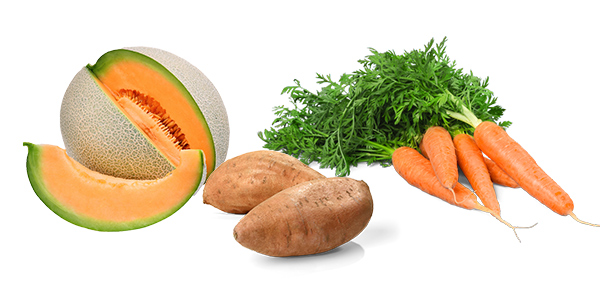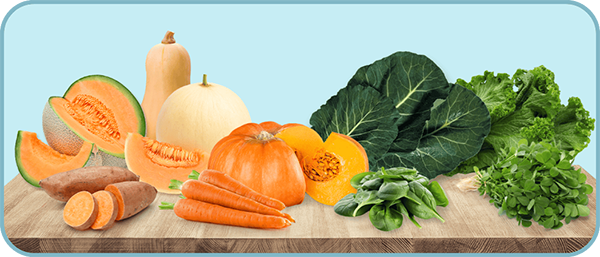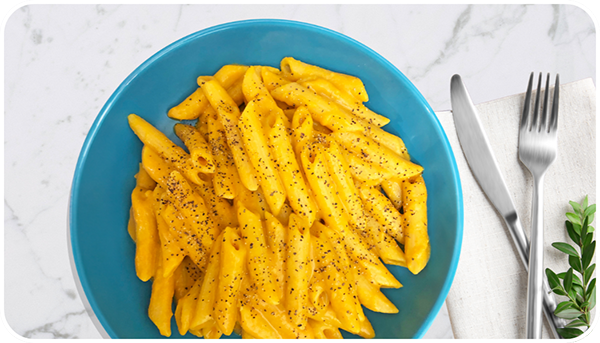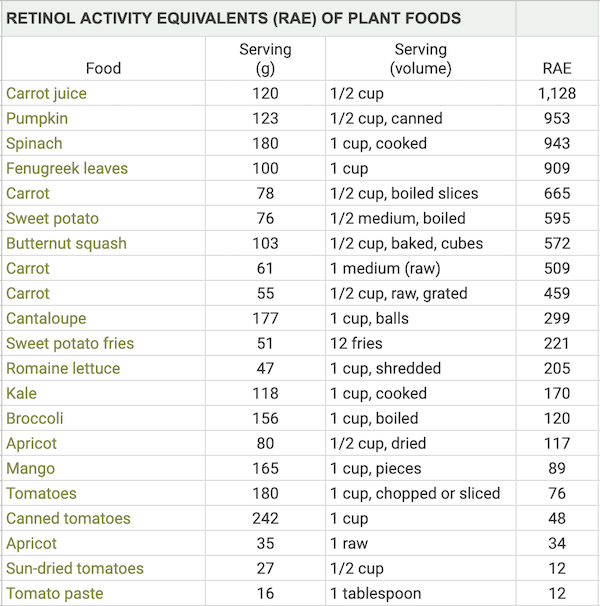
Contents
- Essential Information
- Additional Tips
- Dietary Reference Intakes
- Plant Food Sources of Vitamin A
- Vitamin A Deficiency
- Absorption and Conversion of Carotenoids
- Bibliography
Essential Information
Vitamin A is important for night vision and bone density. Vegans should eat at least two servings of good sources daily. Good sources are vegetables and fruits whose edible flesh is orange: carrots and other root vegetables (1/2 cup), squash (1/2 cup), and melons (2 cups). The orange color indicates beta-carotene which our bodies can turn into vitamin A. Dark leafy green vegetables (1 cup cooked) are also high in vitamin A. Foods with yellow flesh are generally not good sources of vitamin A.

Pumpkin Mac and Cheese Recipe
A great way to help satisfy your vitamin A needs is with pumpkin mac and cheese!

Ingredients
- 12 to 16 oz pasta
- 15 oz can of pureed pumpkin
- 1/2 tsp garlic powder
- 1/2 tsp salt
- 2 tbsp olive oil
- 1 cup of unsweetened soymilk
- 1 cup of nutritional yeast or vegan cheese
Instructions
- Cook the pasta, cool, and set aside.
- Mix the remaining ingredients in a pot on medium heat, stirring constantly, until blended (about 5 minutes).
- Add sauce to the pasta.
- Sprinkle with ground pepper before eating.
Additional Tips
Eating vegetables high in beta-carotene with some fat has been shown to increase both the absorption and synthesis of vitamin A.
Plant Food Sources of Vitamin A
Preformed vitamin A exists only in animal products. However, there are about 50 carotenoids that the body can convert into vitamin A, with the most common being beta-carotene. The vitamin A content of foods is measured in retinol activity equivalents (RAE).
Our spreadsheet, Vitamin A Content of Plant Foods, list most of the plant foods highest in RAE.
Dietary Reference Intakes
| Dietary Reference Intakes for Vitamin A | ||
|---|---|---|
| Age | US DRI (RAE) | Upper Limit (RAE) |
| 0–6 mos | 400 | 600 |
| 7–12 mos | 500 | 600 |
| 1–3 | 300 | 600 |
| 4–8 | 400 | 900 |
| 9–13 | 600 | 1,700 |
| 14–18 male | 900 | 2,800 |
| 14-18 female | 700 | 2,800 |
| ≥ 19 male | 900 | 3,000 |
| > 19 female | 700 | 3,000 |
| Pregnancy | ||
| ≤ 18 | 750 | 2,800 |
| 19–50 | 770 | 3,000 |
| Breastfeeding | ||
| ≤ 18 | 1,200 | 2,800 |
| 19–50 | 1,300 | 3,000 |
The upper limit for vitamin A applies only to the retinol form (found in animal products, fortified foods, and supplements), but does not apply to carotenoids.
Vitamin A Deficiency
Vitamin A deficiency symptoms begin with night blindness and can progress to more severe eye problems such as corneal ulcers, scarring, and blindness (Linus Pauling Institute, 2013). Vitamin A deficiency also reduces the ability to ward off infections. Vitamin A is important for growth and development in infants and children, and for red blood cell formation.
For a discussion of the role of vitamin A and bone health, see the β-carotene and Vitamin A section of our article, Bone Fractures among U.K. Vegans: Implications and Recommendations.
Absorption and Conversion of Carotenoids
Eating vegetables high in carotenoids with some fat has been shown to increase both the absorption and synthesis of vitamin A (Kopec, 2014).
Many factors affect how well dietary carotenoids are absorbed and converted to vitamin A, including body composition, age, smoking, medications, alcohol consumption, food processing, and genetic variation (Moran, 2018, Linus Pauling Institute, 2020). As many as 50% of individuals in some populations may have a low response to beta-carotene and other carotenoids, meaning they either don’t absorb as much as others do or they don’t convert as much to vitamin A (Lietz,2012).
Researchers are looking into how genetic variability impacts the conversion of carotenoids into vitamin A and whether recommendations should vary according to people’s genetic type (Borel, 2017). But at this point, it’s not possible outside of a research setting to determine if someone has a lower response to dietary carotenoids. Even so-called “low-responders” apparently can absorb some dietary carotenoids and convert some to vitamin A (Borel, 2012).
We don’t know the amount of provitamin A carotenoids that is optimal for a low responder who relies exclusively on carotenoids. But choosing a generous amount of foods containing beta-carotene and other provitamin A carotenoids may lead to greater absorption and more conversion in low-responders (Borel, 2015). Until more is known, our best advice is to meet the intake recommendations for provitamin A carotenoids by eating generous amounts of leafy green vegetables, carrots, sweet potatoes, and bright orange winter squashes.
If you have concerns about vitamin A, taking a vegan supplement providing a small amount of preformed vitamin A in the form of retinol is another option. The recommendation for a small amount is because some observational studies have found an increased risk for bone fracture with intakes of preformed vitamin A above 1,500 mcg RAE, only slightly more than the RDA (Feskanich, 2002, Wu, 2014). In any case, preformed vitamin A intakes should not exceed 3,000 mcg RAE (10,000 IU) daily (Food and Nutrition Board, 2001).
Bibliography
Groufh-Jacobsen S, Larsson C, Mulkerrins I, Aune D, Medin AC. Food groups, macronutrient intake and objective measures of total carotenoids and fatty acids in 16-to-24-year-olds following different plant-based diets compared to an omnivorous diet. PLoS One. 2025 Jan 17;20(1):e0311118. Not cited. Measured blood carotenoids in 16 to 24 year old omnivores (1.29 µmol/l), flexitarians (1.56 µmol/l), pescatarians (1.38 µmol/l), lacto-ovo-vegetarians (1.20 µmol/l), and vegans (1.36 µmol/l). Retinol levels weren’t measured.
Linus Pauling Institute. Vitamin A. Accessed 1/25/2013.
Linus Pauling Institute. Carotenoids. Accessed 1/9/2020.
Rotenstreich Y, Harats D, Shaish A, Pras E, Belkin M. Treatment of a retinal dystrophy, fundus albipunctatus, with oral 9-cis-{beta}-carotene. Br J Ophthalmol. 2010 May;94(5):616-21. Not cited. Clinical trial feeding beta-carotene to people with a genetic defect in the retinal cycle. After 90 days, night blindness improved.


15 thoughts on “Vitamin A”
Thanks for all the helpful info. What do you think about what Dr Fuhrman says about the dangers of vitamin A supplements?
https://www.drfuhrman.com/blog/71/harmful-ingredients-in-supplements-picking-the-right-multivitamin-is-paramount-as-most-may-be-harmful-to-your-health
Hayley,
Here are two articles from the Linus Pauling Institute that you might find helpful:
https://lpi.oregonstate.edu/mic/dietary-factors/phytochemicals/carotenoids
https://lpi.oregonstate.edu/mic/vitamins/vitamin-A#safety
The amount of beta-carotene and vitamin A in multivitamins are typically measured in micrograms whereas the amounts in clinical trials that have shown harmful effects are measured in milligrams and tend to be much higher. So, I wouldn’t be worried about the amounts in multivitamins though I wouldn’t take high-dose beta-carotene or vitamin A supplements.
As long term vegans, my partner and I are both deficient in vitamin A (retinol); we had our levels tested before we became vegan. Within 1 year of no supplementation we became severely deficient in vitamin A and developed eye, skin, and immune issues. This was in spite of drinking 1 cup of carrot juice a day, 200 grams sweet potato, 100 grams cantaloupe, and eating a wide variety of greens, in addition to including a modest (10 grams) of fat with each meal to aid absorption. Supplements did raise our levels, but without at least 900 mcg daily, the levels begin to fall. Vitamin A is definitely overlooked so I appreciate bringing this issue to light.
Sounds like you might have had some kind of extreme absorption impairment or some other underlying condition.
How common is Vitamin A deficiency among vegans? Are the vitamin A levels different from the general population?
Vitamin A levels in vegans are discussed in the β-carotene and Vitamin A section of our article Bone Fractures among U.K. Vegans: Implications and Recommendations.
yo, USDA food database states that carrot juice has 0 retinol… lmao
https://fdc.nal.usda.gov/fdc-app.html#/food-details/342399/nutrients
Correct. As stated in this article, retinol is preformed vitamin A (found in animal-based foods). Plant foods contain carotenoids which the body converts to vitamin A. As stated in this article, 1 IU beta-carotene from foods is equivalent to 0.05 mcg RAE and 1 IU beta-carotene from dietary supplements is equivalent to 0.15 micrograms RAE.
Hi, what does the “C” in column “Size” stand for?
C = cup (8 ounces or 240 mL)
Not sure if there has been additional findings on this topic. https://www.sciencedaily.com/releases/2009/11/091118072051.htm
We looked into this and updated the absorption section of this article: https://veganhealth.org/vitamin-a/#absorption
And added a blog post: https://veganhealth.org/vitamin-a-updated/
Pumpkin contains beta-carotene, a precursor to vitamin A. Beta-carotene and other carotenoids are fat-soluble. The plant sources of vitamin A in the table are carotenoids and are fat-soluble. As we note on this page, “eating vegetables high in carotenoids with some fat has been shown to increase both the absorption and synthesis of vitamin A (2).”
Hi
Thanks but what about for people over 50? No recommended doses for Vitamin A?
Take another look at the table of Dietary Reference Intakes on this page – there are recommendations for those 19 years and older.